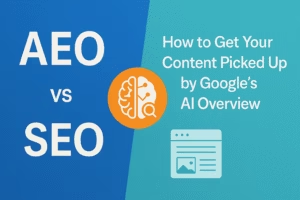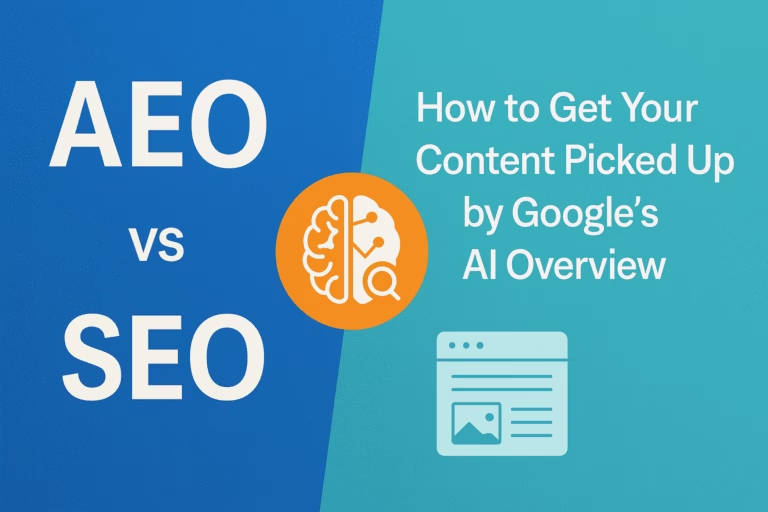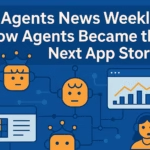Key Takeaways
- •
AEO vs SEO is an upgrade, not a fight. Use SEO for reach and AEO for authority. - •
Google’s AI Overview prefers clear, direct answers written in structured chunks. - •
Start sections with real questions users ask, then answer in one tight paragraph. - •
AI rewards confident, helpful tone. Cut fluff, keep facts, show expertise across posts. - •
Pair SEO for discovery with AEO for citations to future-proof your content strategy.
There’s a quiet extinction happening online.
Every time you Google something, fewer websites survive the scroll. Google’s new AI Overview gives users the answer instantly, skipping the middlemen and most content creators are the middlemen.
For years, the game was about SEO: climb the rankings, collect the clicks, and pray your meta description was sexy enough to earn traffic. But the rules changed. Google now uses AI to synthesize answers, not just find them.
This is where AEO (Answer Engine Optimization) comes in. It’s not about ranking higher it’s about being trusted enough for the AI to cite you when it speaks.
If your business depends on organic reach, understanding this shift isn’t optional. It’s survival strategy.

SEO → AEO: The Shift
For a decade, SEO felt like the only game worth playing. You researched keywords, wrote your 1,500 words, and waited for Google’s crawler to nod in approval. It was mechanical, predictable, and in its own way, safe.
That world is gone.
Google’s AI Overview changed the nature of discovery itself. Instead of showing ten blue links, it now summarizes the web for users. It scans, understands, and assembles its own mini-report before anyone clicks anything. That’s great for users, but brutal for websites built on traffic.
Enter AEO. Short for Answer Engine Optimization, it’s the process of teaching your content to talk like an expert, not just look like one. It’s less about keywords and more about usefulness.
If Google’s AI sees your article as the clearest, most direct answer, you earn a spot inside the AI summary itself. That visibility builds credibility faster than any headline trick ever could.
The mindset shift is simple: stop writing for clicks and start writing for confidence. Your goal isn’t to bait attention; it’s to become the source the AI trusts to explain the topic correctly.
SEO vs AEO: What Actually Changed
The difference between SEO and AEO looks small on the surface but changes everything underneath. SEO still matters, but now it’s the first layer. AEO sits above it, where Google’s AI decides which ideas deserve to be spoken aloud.
Here’s how they compare:
| Element | SEO (Search Engine Optimization) | AEO (Answer Engine Optimization) |
|---|---|---|
| Goal | Rank higher on Google results pages | Be cited inside Google’s AI Overview |
| Primary Audience | Human readers browsing search results | Google’s AI system extracting clear answers |
| Content Format | Long-form blogs, keyword-dense copy | Structured summaries, short paragraphs, bullet lists |
| Key Metric | CTR, dwell time, backlinks | Answer accuracy, source trust, snippet inclusion |
| Best Use Case | Building long-term search visibility | Winning AI citations and top-of-page authority |
SEO taught us to chase visibility. AEO asks us to earn authority. The better your content explains the question, the more likely the AI is to borrow your words when answering.
How to Use ChatGPT to Rank in AEO
Most creators are still fighting yesterday’s battle. They feed keywords into AI writers, crank out a 2,000-word post, and wonder why Google buries it. The reason? AI Overviews don’t care about your word count. They care about precision.
To win in AEO, use AI tools differently. You’re no longer prompting for paragraphs you’re prompting for clarity.
Here’s a smarter workflow you can test today:
- Ask for real search intent.
Use ChatGPT to find questions people actually type. Try: “List 10 long-tail questions about [topic] that real users search for.” These queries are what Google’s AI scans to decide relevance. - Turn answers into structured snippets.
Once you’ve got your list, ask ChatGPT: “Write clear, one-paragraph answers for each question as if it will appear in Google’s AI Overview.” This creates content that mirrors the tone the AI prefers neutral, factual, and well-organized. - Simulate an AEO audit.
Copy a published AEO snippet and paste it into ChatGPT. Then ask: “What structure and tone is Google favoring here?” You’ll learn how to match the rhythm of winning content. - Rephrase for confidence, not clickbait.
Google’s AI avoids dramatic phrasing. Swap “shocking truth about backlinks” for “key factors that affect backlink strength.” Authority reads clean.
Pro tip: Before you publish, read your intro aloud. If it sounds like something you’d tell a coworker to explain a concept quickly, it’s AEO-ready.
Tools like Blaze Autopilot can help automate this audit loop by checking tone, keyword coverage, and factual density across drafts.
When to Target AEO vs SEO
Not every article should chase the AI Overview. Sometimes, classic SEO still delivers better returns especially if you’re targeting readers who want depth, not just answers. The trick is knowing when to switch gears.
Choose SEO-first when:
- You’re educating or storytelling (blogs, guides, or case studies).
- You need sustained organic traffic over time.
- The topic benefits from long-form exploration.
Choose AEO-first when:
- Your audience wants direct answers fast (how-tos, definitions, comparisons).
- You’re explaining something that can fit neatly in 3-5 sentences.
- You’re optimizing for voice assistants or AI-powered summaries.
The sweet spot is balance. Use SEO to build discoverability and AEO to build authority. SEO earns attention. AEO earns trust. Together, they future-proof your content strategy.
The writers who learn both won’t just survive Google’s next evolution they’ll become the sources the AI quotes.
Pro Tips and AI Strategies
The good news is that Google’s shift toward AI Overviews isn’t a death sentence for SEO. It’s an upgrade in disguise. The people who adapt early will control the narrative, not chase it. Here’s how to future-proof your content before everyone else catches on:
1. Start with “why,” not “what.”
Most creators still write around keywords instead of insights. Google’s AI looks for context that teaches, not repeats. Lead with purpose, and the AI sees value.
2. Use headings like signposts.
Every H2 should read like a question your audience might actually ask. Think: “How does AEO help small businesses?” instead of “The benefits of AEO.” Natural language indexing thrives on clarity.
3. Keep answers snack-sized.
The AI Overview rarely pulls walls of text. It prefers sharp, self-contained explanations. One concept per paragraph is the new rule.
4. Build credibility across articles.
AI trusts consistent expertise. The more your site produces focused, high-signal content around a single niche, the more likely it is to appear in summaries.
5. Audit your tone.
AI models quote voices that sound confident and useful – not robotic. If your writing could double as customer support text, rewrite it. Add human rhythm back in.
The evolution of AEO vs SEO isn’t about fighting algorithms. It’s about aligning with how people actually think. The AI isn’t your enemy.
It’s your amplifier if you feed it content worth amplifying.
Summary
Google didn’t kill SEO. It just turned it inside out.
Answer Engine Optimization is the natural next step in a longer story: from keywords, to content, to clarity. The creators who master both SEO and AEO won’t just show up in search results they’ll own the answers everyone else is quoting.
The internet is shifting from a library to a conversation, and the smartest move now is to speak the AI’s language fluently enough to be cited when it talks back.


